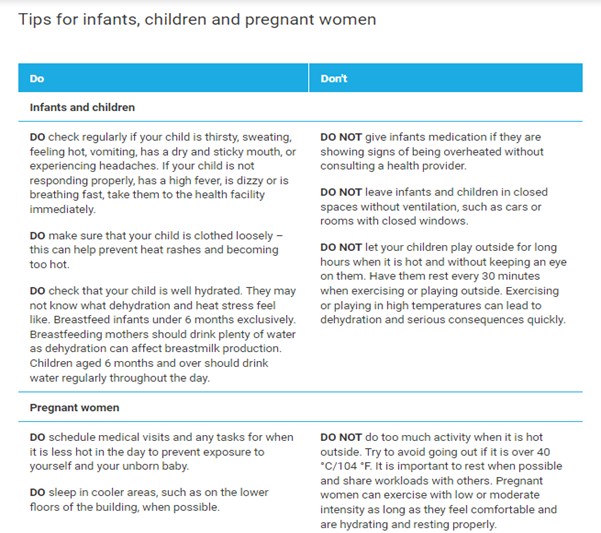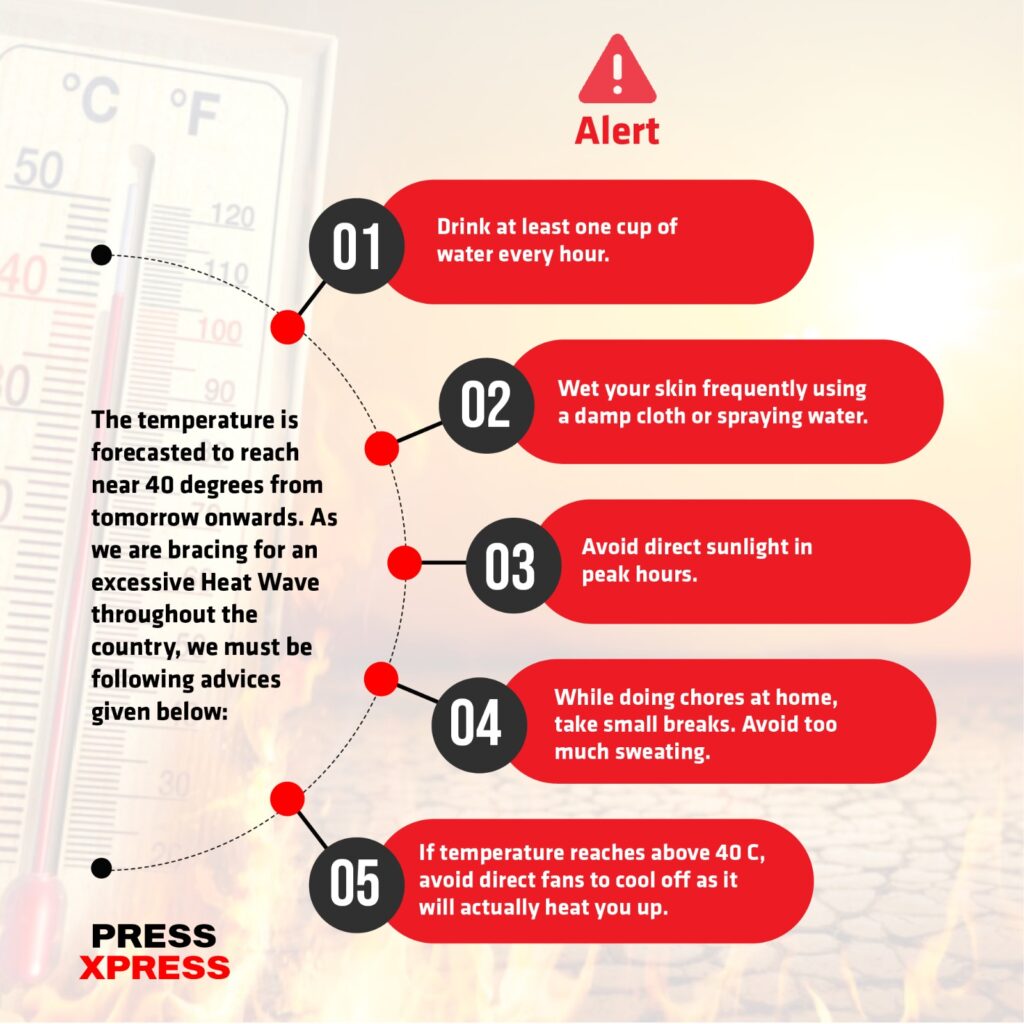According to the Bangladesh Meteorological Department (BMD), six divisions, including Dhaka, are currently grappling with mild to moderate levels of a heat wave
In the era of the Climate Emergency, extreme weather has become an undeniable reality of life. Heatwaves, especially prevalent in tropical regions, have intensified, and Bangladesh is feeling the brunt of it. With soaring temperatures compounded by high humidity, cities like Dhaka transform into veritable furnaces, making daily life exceedingly challenging.
You Can Also Read: HOW TO SURVIVE THE HEATWAVE?
According to the Bangladesh Meteorological Department (BMD), six divisions, Dhaka included, are currently grappling with mild to moderate levels of a heat wave, a situation expected to persist for the next five days starting from April 15 (2024).
Rangamati registered the country’s highest temperature, hitting 40 degrees Celsius on April 14.
“Mild to moderate heat wave is sweeping Rajshahi, Dhaka, Khulna, Barishal, Chattogram, Sylhet divisions and Rangpur and Nilphamari districts and it may continue,” said a Met office bulletin.
In Bangladesh, temperatures of 36 to 38 degrees Celsius are classified as a mild heatwave, 38 to 40 degrees Celsius as a moderate heatwave, and anything above 40 degrees Celsius as an intense heatwave.
Currently, a trough of westerly low-pressure hovers over Bangladesh and neighboring regions, while a seasonal low-pressure system sits over the South Bay. Furthermore, there are predictions of rain or thundershowers in Rangpur, Dhaka, Mymensingh, Chattogram, and Sylhet divisions within the next 24 hours from 9 am on April 17.

Why Do Heat Waves Occur So Frequently Nowadays?
Climate change is a global issue, but its impacts will be particularly devastating and unbalanced for developing and underdeveloped economies. These countries lack adequate resources, science, and technology to adapt to the changing environment. Bangladesh stands out as an acute example, being one of the most endangered coastal countries due to global warming.
According to World Weather Attribution, what was once considered a 100-year extreme heatwave would be 30 times more likely to occur today with the current level of global warming.
Furthermore, warmer air often comes with humidity by holding and transferring the evaporated liquid water from soils, plants, and oceans into the atmosphere. The combination of extreme heat and humidity, or so-called ‘wet-bulb’ temperatures, makes heat waves more dangerous to human life.

Amidst these environmental challenges, the need for comprehensive global cooperation and policy reforms becomes increasingly imperative.
Children are at Risk, says UN
The UN issued a warning on Thursday 11 April, 2024 about the severe heatwaves affecting East Asia and the Pacific, posing a significant risk to millions of children. With 2024 likely to be the hottest year on record, global monitors have highlighted the urgency of addressing climate extremes and escalating greenhouse gas emissions. UNICEF data revealed that over 243 million children in the region are at risk due to heatwaves, potentially leading to heat-related illnesses and fatalities. As temperatures soar above 40 degrees Celsius in several countries, including the Philippines and Thailand, concerns are mounting about the health impacts, especially on vulnerable populations. Children are particularly vulnerable to heat-related risks due to their limited ability to regulate body temperature. Urgent action is needed to protect communities from the worsening impacts of heatwaves and other climate-related shocks, as projections suggest that over two billion children could be exposed to heatwaves by 2050.

Health Guideline for Heat Wave
Bangladesh is currently facing extreme heat, with temperatures soaring up to 40°C in certain regions, leading to discomfort, health issues, and even fatalities. In this piece, we’ll delve into the hazards of extreme heat, ways to safeguard oneself and others during a heatwave, and the role of climate change in exacerbating extreme heat in Dhaka, Bangladesh.
What are the dangers of extreme heat?
Extreme heat can result in various health problems, ranging from mild discomfort to life-threatening conditions, including:
- Heat exhaustion and heat stroke: Symptoms encompass dizziness, weakness, headache, nausea, vomiting, and high body temperature. If untreated, heat exhaustion can escalate to heat stroke, constituting a medical emergency.
- Dehydration and electrolyte imbalance: Excessive sweating leads to fluid and essential mineral loss, potentially causing dehydration and electrolyte imbalance.
- Aggravation of chronic health conditions: Extreme heat can worsen pre-existing conditions like heart disease, respiratory issues, and diabetes.
Protection from extreme heat
Here are several steps:
- Stay hydrated and avoid sugary drinks: Consume ample water, coconut water, or other non-alcoholic beverages to maintain hydration. Steer clear of sugary drinks and alcohol, which can exacerbate dehydration.
- Wear loose, light-colored clothing: Opt for loose-fitting, lightweight attire in light colors to facilitate cooling. Dark colors absorb more heat, intensifying discomfort.
- Limit outdoor activities during peak heat hours: Minimize outdoor activities, especially between 11 am and 3 pm, the hottest part of the day. If venturing outside, wear a hat and use an umbrella for shade.
- Utilize air conditioning or fans if available: Employ air conditioning or fans to cool indoor spaces. Alternatively, take cool showers or baths to lower body temperature.
For vulnerable individuals:
- Check on elderly relatives, neighbors, or friends: Ensure they have access to cool, shaded areas, sufficient water, and food.
- Offer hydration and a cool resting place: Provide water or non-alcoholic beverages to those in need and offer a cool, shaded area for relaxation.
- Seek medical assistance if necessary: If someone exhibits signs of heat-related illness, promptly contact local authorities or emergency services for help.
How is climate change impacting extreme heat in Bangladesh?
Climate change exacerbates extreme heat by increasing its frequency, intensity, and duration. This affects various aspects such as agriculture, food security, and public health. Measures to adapt to and mitigate climate change effects are crucial, including investing in resilient infrastructure and promoting renewable energy sources.
According to reports, Bangladesh is currently experiencing extreme heat, with temperatures reaching 40.4 degrees Celsius in Dhaka, the highest in 58 years. Previous records in Dhaka were set in 1965, with temperatures hitting 42 degrees Celsius. Other districts in the country are also facing mild heatwave conditions. Extreme heat results in discomfort, health issues, and fatalities for some individuals. Furthermore, climate change worsens the frequency and intensity of heat wave in Bangladesh and globally. The effects of extreme heat on agriculture, food security, and public health are increasingly concerning.


